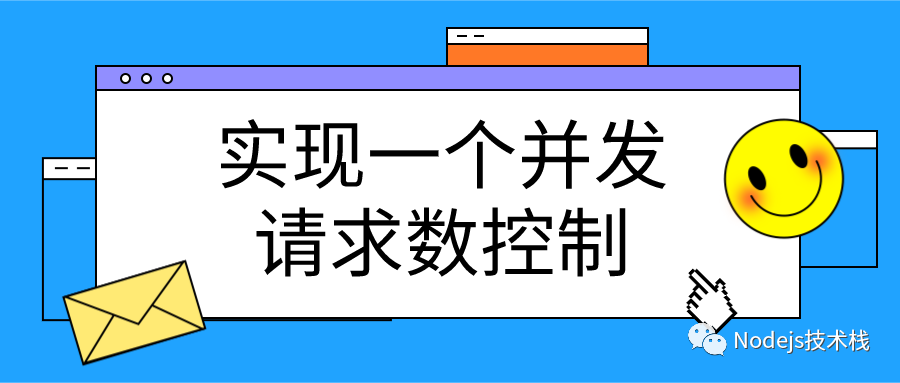实现浏览器中的最大请求并发数控制

探究 Chrome 浏览器并发请求数控制
如下代码示例,定义一个 HTML 并在页面打开时加载 8 张图片。
<!-- connection.html -->
<html>
<body>
<img src="/test1.jpg" alt="" />
<img src="/test2.jpg" alt="" />
<img src="/test3.jpg" alt="" />
<img src="/test4.jpg" alt="" />
<img src="/test5.jpg" alt="" />
<img src="/test6.jpg" alt="" />
<img src="/test7.jpg" alt="" />
<img src="/test8.jpg" alt="" />
</body>
</html>下面使用 Node.js 启动一个服务,当请求为 host:port/ 时响应上面定义的 html 文件,其它情况下则响应图片。示例中用到的图片示例,可自行定义。
// connection.js
const http = require('http');
const fs = require('fs');
const port = 3010;
http.createServer((request, response) => {
console.log('request url: ', request.url);
const html = fs.readFileSync('./connection.html', 'utf-8');
const img = fs.readFileSync('./test_img.jpg');
if (request.url === '/') {
response.writeHead(200, { 'Content-Type': 'text/html' });
response.end(html);
} else {
response.writeHead(200, { 'Content-Type': 'image/jpg' });
response.end(img);
}
}).listen(port);
console.log('server listening on port ', port);打开 Chrome 浏览器,在 Network 里调整网络为 3G 能更好的看到效果,运行上面的程序,如下所示:
运行的结果中有一个 ConnectionID 字段,这个表示了每次请求创建的链接,前 6 张图片是一次并发请求,第 7 张和第 8 张,刚开始阶段一直处于 Pending 状态,直到前面 6 个其中的任一个完成之后,才会去请求,这个时候就会产生响应等待,对用户表现就是页面一直在加载,如果是这种情况,原因则是请求太多后续的需要前面的完成才能进行。
在 Chrome 浏览器中允许的最大并发请求数目为 6,这个限制还有一个前提是针对同一域名的,超过这一限制的后续请求将会被阻塞。
以下是 Chrome 浏览器关于最大请求链接数的一段介绍和相关代码,另外 Chrome 浏览器是不能修改这个值的,在源码里可以看到是固定写死的。
https://chromium.googlesource.com/chromium/src/+/65.0.3325.162/net/socket/client_socket_pool_manager.cc#44
// Default to allow up to 6 connections per host. Experiment and tuning may
// try other values (greater than 0). Too large may cause many problems, such
// as home routers blocking the connections!?!? See http://crbug.com/12066.
int g_max_sockets_per_group[] = {
6, // NORMAL_SOCKET_POOL
255 // WEBSOCKET_SOCKET_POOL
};实现一个并发请求控制类
实现一个类似上面浏览器中的并发请求控制类,以下是我们实现的思路:
- 行 {1} 定义一个自己的并发请求控制类在实例化时设置 limit
- 行 {2} 为这个这个并发请求控制类实现一个 request 方法
- 行 {3} 在 request 里判断如果当前请求数大于设置的 limit 程序进入阻塞状态
- 行 {4} 在 request 请求里如果当前请求数小于设置的 limit,处理传入的请求
- 行 {5} 在处理传入的请求开始时要对当前请求数做加 1 操作
- 行 {6} 在处理传入的请求完成时判断如果阻塞队列有值,将最先进入到阻塞队列的请求从 Pending 变为 Fulfilled 这样就会开始处理传入的请求
class RequestLimit {
constructor (limit) {
this.limit = Number(limit) || 2; // {1}
this.blockQueue = [];
this.currentReqNumber = 0;
}
/**
* 请求
* @param {*} req
*/
async request(req) { // {2}
if (!req) {
throw new Error('req is required.');
}
if (Object.prototype.toString.call(req) !== '[object Function]') {
throw new Error('Req must be a function.');
}
if (this.currentReqNumber >= this.limit) { // {3}
await new Promise(resolve => this.blockQueue.push(resolve)); // 阻塞队列增加一个 Pending 状态的 Promise
}
return this._handlerReq(req); // {4}
}
/**
* 内部方法处理请求
* @param {*} req
*/
async _handlerReq(req) {
this.currentReqNumber++; // {5}
try {
return await req();
} catch (err) {
return Promise.reject(err);
} finally {
this.currentReqNumber--;
if (this.blockQueue.length) { // 每完成一个就从阻塞队列里剔除一个
this.blockQueue[0](); // 将最先进入阻塞队列的 Promise 从 Pending 变为 Fulfilled
this.blockQueue.shift();
}
}
}
}上述代码有一个重点是 this.block() 函数如何实现阻塞,这一块可以借助 Promise 实现,在 new Promise 时回调函数会给我们返回一个 resolve 函数,如果执行这个 resolve 函数,Promise 的状态会变更为 Fulfilled 所以我们这里不会立即执行,而是先保存到阻塞队列里,待前面的请求完成之后再从阻塞队列里取出,相当于执行了 resolve 函数,如果理解 Promise 源码实现的会好理解些。
创建一个 index.html 文件,在浏览器里测试下上述程序。
<html>
<body>
<script src="https://cdn.bootcdn.net/ajax/libs/fetch/3.1.0/fetch.min.js"></script>
<script src="./request-limit.js"></script>
<script>
const requestLimit = new RequestLimit(2);
(async () => {
for (let i=0; i<8; i++) {
requestLimit.request(() => fetch("http://q.qlogo.cn/qqapp/100312990/DE1931D5330620DBD07FB4A5422917B6/100"));
}
})()
</script>
</body>
</html>限制最大请求并发数为 2 借助 Chrome 浏览器瀑布流的方式可以很清晰的看到请求的结果。
上述代码地址:
https://github.com/qufei1993/examples总结
本文一开通过示例演示了在 Chrome 浏览器中的并发请求控制,在同一个域名的情况下 Chrome 浏览器允许的最大请求并发数为 6 当然其它浏览器都会有,只是每个浏览器的限制是不同的,当我们了解到这个规则之后在日常的工作中,也要尽可能的减少页面一些无谓的请求。
在本文的第二个部分自己实现了一个 RequestLimit 类,来模拟实现类似浏览器中的并发请求数控制,代码部分也很精简